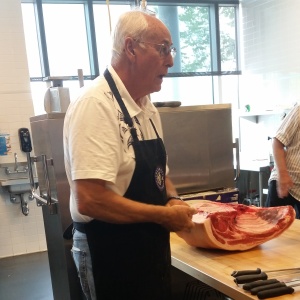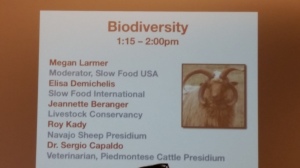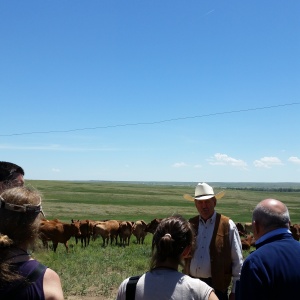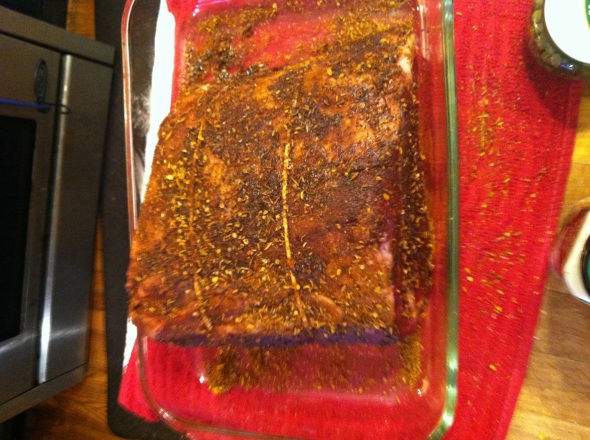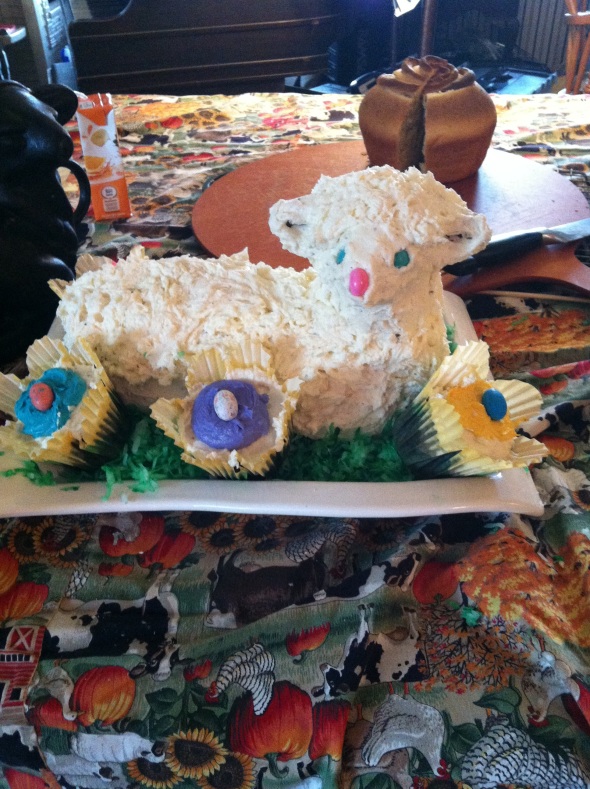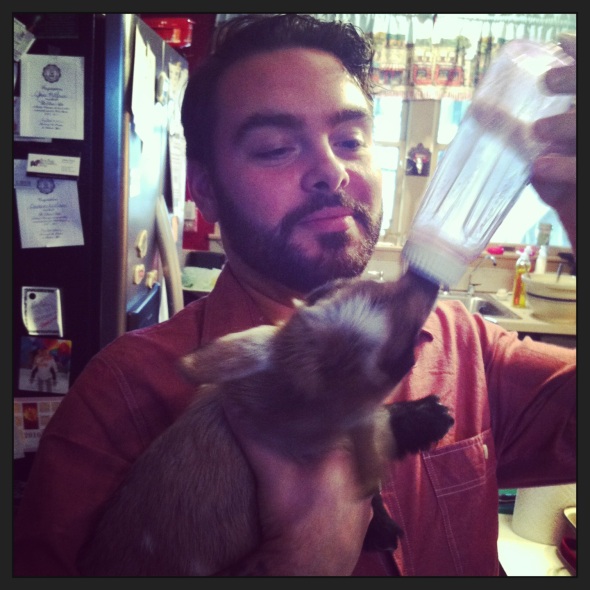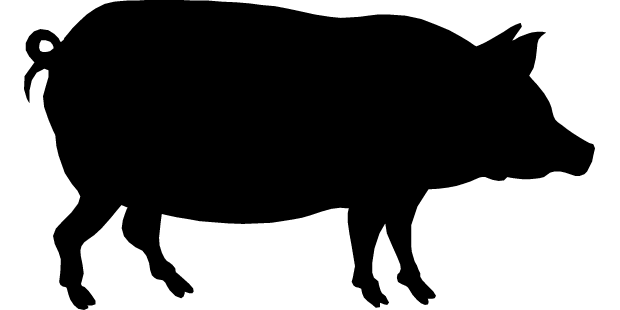A New Blog to Follow/View
Posted: November 12, 2014 Filed under: Uncategorized | Tags: animals, artisan, beef, butcher, cooking, food, foodies, grill, grilling, lamb, meat, pork, recipes Leave a commentPlease find my (Tim, the Butcher) new blog here. I will continue posting the same types of information that have always been here, and may even borrow some posts I have on this blog. This blog will be gathering dust, unless Austin has anything to add.
Slow Meat Day 3
Posted: July 18, 2014 Filed under: Uncategorized Leave a commentFar and away the best day of Slow Meat 2014 for me. I was honored to meet Francois Vecchio, butcher and salumier. Watching him break a pork shoulder was akin to a Catholic listening to a homily from the Pope in the Vatican.
Slow Meat Day 2
Posted: July 18, 2014 Filed under: Uncategorized Leave a commentThe second day of Slow Meat in Denver, Colorado is where things got interesting. And confusing. Less than 24 hours removed from our trip to the Lassiter Ranch, purveyors of Beefmaster cattle, one of the topics we were discussing was Biodiversity.
Clearly, discussing biodiversity for 45 minutes was not nearly enough time. However, Beefmaster cattle (as well as Angus and Hereford) were specifically called out as being detrimental to biodiversity. I was confused. We spent most of the day at a ranch devoted to this breed, then the next day are told that it isn’t what we want in Slow Meat…curiouser and curiouser.
What biodiversity is aiming for is a return to heritage breeds, to stock that isn’t a one size fits all for the consumer. I spoke to one pig farmer from Virginia, Josiah Lockhart for quite some time, and he listed off the breeds he prefers for lard, for bacon, for hams, etc etc. He raises a very rare breed, the Mule Foot, which he retails at $9/lb. Quite a hefty price, but he is booked 3 months ahead on orders. Being close to the Washington, D.C. metro area doesn’t hurt.
You will notice at the bottom of the page the name Dr. Sergio Capaldo. This is a man dear to me and to my bosses, as he is the man almost solely responsible for the propagation of the Piedmontese breed.
After our symposiums, we watched an entire bison broken down from start to finish. 
Again, I was slightly confused. The bison they used was frozen. Being a butcher, I did not envy the men as they wrestled with cutting through what was, honestly, almost solidly frozen bison. I would have expected something a little…fresher from Slow Meat. This bison would later be served as carpaccio among other dishes.
Slow Meat Day 1
Posted: July 18, 2014 Filed under: Uncategorized Leave a commentA few weeks ago, I was given the opportunity to travel to Denver, Colorado for a conference dedicated to the production and distribution of sustainably raised animal proteins. The conference was run by Slow Food USA, and was entitled, appropriately, Slow Meat. The conference lasted three days and included a farm tour, an exhibition of bison butchery, and a number of symposiums lead by men and women dedicated to bringing good meat to good people.
Day one was spent on the Lassiter Ranch, owned by Dale Lassiter.
The Lassiter Ranch is just outside of Denver, and is, in a word, expansive. The land out there is sparse, not exactly suitable for raising cattle solely on grass. Lassiter, however, has perfected his methods, and, by growing Beefmaster cattle (a breed developed by his father some years ago in Texas), has a booming business. His cattle require 30 acres of pasture per head. He raises around 900 head.
Picanha
Posted: October 22, 2013 Filed under: Uncategorized | Tags: brazil, butcher, cooking, food, meat, picanha 2 CommentsWhen I began at Bluescreek, the picanha (pee-con-ya) was something very few people knew anything about. Indeed, I had never heard of the delectable morsel until a Brazilian customer asked about it. He attempted to explain it as best he could, but I had no idea what he was talking about, but I told him I would research it and call him back once I figured it out. I went home that night, switched on my laptop and got to work. About eight seconds after opening my laptop, I had found what I was looking for. Google really is an amazing thing.
Picanha is a poplular cut in South America, particularly in Brazilian-style steak houses called churrascarias. The name is derived from the Spanish/Portuguese word churrasco, a style of barbecuing. In these churrascarias, the meat is cooked over an open fire on long, sword-like skewers. These skewers are then brought out to the customer where a passadore carves off pieces of exquisitely flavored meats; anything from the picanha to duck to poultry and pork.
The picanha is the cap from the top sirloin roast. This is, in fact, what will become the “regal” rump, or first cut rump. It is very tender, and due to the fat cap left on the small roast, extraordinarily juicy. To cook at home, grilling is best, indirect heat to a medium rare, or your liking. Blue rare for me, thanks. But do get the fat soft. None of that should go to waste.

The picanha begins below the sirloin roast, seen here. The picanha is the thin piece of meat at the bottom.
Goat
Posted: September 30, 2013 Filed under: Uncategorized 1 CommentGoat meat is becoming increasingly popular, not just for the adventurous any more. It is becoming decidedly mainstream. At Bluescreek, we have been selling out weekly, and demand is on the rise. When I first began working for David and Cheryl, we broke down one goat perhaps every other week, maybe every three weeks. We are now moving an entire goat every week.
Goat meat is a lean, red meat more reminiscent of beef than of lamb. Most of the goat we sell is in bone-in stew form. The loins, ribs, bellies, and legs are left whole, or cut into chops. The remainder is cut into stew.
Here is a recipe for Carribean Goat stew.
Working with Restaurants
Posted: July 9, 2013 Filed under: Uncategorized Leave a commentSince working with Bluescreek Farm Meats, I have had the pleasure of working with some of the finest chefs in Columbus. We regularly sell to establishments such as Knead, Alana’s Food and Wine, Latitude 41, Till Dynamic Fare, L’Antibes, and, most recently M at Miranova by Cameron Mitchell. These restaurants don’t get any discounts on our products, and are instrumental to getting our message of local, sustainable foods to folks who may not have otherwise heard of us. We are continually reaching out to new clients, and I will hopefully be making a trip up north to Cleveland sometime in August to get our product in the Greenhouse Tavern. I am so pleased to work with and for people who keep such high standards of quality in their establishments.
Taking the Fear Away From Eating Seafood
Posted: May 26, 2013 Filed under: Uncategorized Leave a commentLet’s face it- there just aren’t enough fish eaters out there compared to land animal eaters. People still have a fear of eating seafood, especially unfamiliar varieties. I came from a generation (born in the 8o’s) where there just wasn’t alot of fresh fish options available to the average class consumer, especially in my land-locked community. The grocery store salmon, cod, shrimp or crab was dull, not fresh, probably previously frozen and probably not even from this country. I grew up turning up my nose at fish because it tasted ‘too fishy’ as I’m sure most of us did. But this is what I thought all fish tasted like.
As we saw and became more exposed to how factory farms were treating animals we began to care more about making the right decisions when it came to what meat we ate. We are investing time into heritage breeds, free range, humanely treated, and nose to tail eating now. Fish, however still has some catching up to do. We are and continue to be reminded that fish is a threatened food source. Decades of pressure from overfishing has put this wild food source at risk. However, there are a ton of small fisherman and fisheries out there that are doing the right thing and are deemed sustainable. Why don’t we hear about them more than we hear about the problems? Well, because they are just the small guys, big ocean.
It’s a no brainer to agree that, like meat, we need to support the endeavors of local fisherman and sources. We as chefs, artisans, retailers, educators, or just ‘foodies’ need to help take the fear away about eating fish. I started my exploration (now obsession) with this very. Not just the salmons, cods, shrimp, but the lesser known species, the ‘heritage’ or forgotten species so to say of the ocean. Fish like Tilefish, Mackerel, Porgy, Wreckbass or Hake are all examples of fish that a good chunk of us just don’t know anything about.
How do we start? With stories. Nothing sells food more today than knowing how it came to be, how it came into your arms to sell, to cook or to eat. Where was the fish caught? What fishing method was used? Whats the name of the fisherman’s boat? What kind of clothes does the fisherman wear? These are all questions that people gleam about when talking about food selling points. Sometimes it’s not about the steak or fish fillet on the plate, It’s the story of how it came to be.
Today when I go to a restaurant or a market, I judge them overall on the fish they offer. Great local, sustainable and interesting fish can be obtained anywhere these days regardless of your geographic relevance to the ocean. The restaurants that continue to ‘hide’ the fish by offering poorly farmed options or imported don’t really do it for me. However, when I see more exotic names of fish on a menu I am rest assured that there is a chef in the kitchen that is passionate about helping revive the overall perception of seafood through educating his customers and telling a story.
Easter, 2013
Posted: April 1, 2013 Filed under: Uncategorized | Tags: beef rib roast, Family, food, foodies 1 CommentThis Easter was undoubtedly the best I have ever had. It began with attending Easter Mass in a Catholic church (I was raised Lutheran and haven’t been to church in over a decade…which makes me feel rather old…) and ended with bottle feeding an orphaned baby goat. In between was filled with everything that Easter is about; love, family, beginnings, closeness…and food. Here, I will focus on the food.
My wonderful girlfriend, Carley was kind enough to invite me to her family’s Easter gathering this year. Her dad prepared these amazing lamb sirloin roasts, dried apricots and rosemary on top of a sweet glaze, then roasted quickly in the oven for a wonderful medium rare.
A mid-rare beef standing rib roast was also on the menu. Carley’s dad rubbed it with a Caribbean inspired concoction, and it was absolutely delicious.
I was so excited to eat everything on the table, I completely neglected to photograph the entire spread. There were glazed carrots, a fantastic salad with goat cheese and cranberries, brussel sprouts with candied walnuts, challah, potatoes au gratin, and this:
All of the food was amazing. It was a potluck of sorts, everyone contributing something to the table. It made me feel at home, welcome, accepted to be a part of the meal.
And then there was this little guy, who I fed…
His name is Campo. His mother died during his birth, so he is now being bottle raised and is completely adorable. This is precisely what Easter is about, life and the promise of new beginnings. Many thanks for reading, and I hope your holiday was as enjoyable.
On Grilling
Posted: March 24, 2013 Filed under: Uncategorized Leave a commentGrilling can be scary. I understand. You bought an expensive piece of meat, you don’t want to burn it, but you don’t want it to be completely raw (for reasons I don’t actually understand. As long as my meat is hot, it’s done.)
SO! Here are a few tips before the grilling season officially gets underway.
1. Directly over the flame is not always the best method of grilling. But, Tim! That’s where the heat is! Yes, it is. It is also where the flame is not. The closer to the flame, the higher the heat. You can experience this phenomenon quite easily by lighting a match and letting it burn all the way to your fingers. (Don’t actually do this.) Indirect grilling is usually best. I’ll go over indirect grilling later.
2. Know the fat! If you have a lean piece of meat, it will cook much faster than a fatter piece.
3. Pork DOES NOT HAVE TO BE WELL DONE. People often complain about dry pork chops. It’s already dead, you don’t have to kill it. Trichinosis isn’t really a thing anymore. According to Wikipedia, there were an average of 11 cases/year from 2002-2007. I’ll take my chances to have a delicious pork chop.
My preferred method of grilling is natural wood charcoal. It takes longer, certainly, but the reward is so much greater. After natural wood charcoal, I’d use regular charcoal. Gas is my least favorite. I just don’t care for the flavor it imparts on the meat.
Indirect grilling. It’s easy. Don’t be afraid. Buy a nice thick piece of meat (at least 3/4 of an inch thick). Place the meat directly over the flame for 30 seconds to a minute on each side. Move the meat to a cooler area of the grill, away from the flame, and give it about 3-4 minutes/side for mid rare. Up the time to your desired state. Enjoy!
